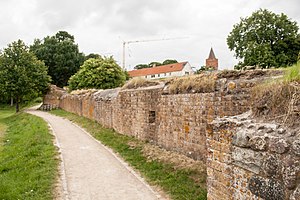| Siege of Vordingborg | |||||||
|---|---|---|---|---|---|---|---|
| Part of the Danish–Hanseatic War (1361–1370) | |||||||
 Remnants of Vordingborg Castle (2013) | |||||||
| |||||||
| Belligerents | |||||||
|
|
| ||||||
| Commanders and leaders | |||||||
|
|
| ||||||
| Units involved | |||||||
| Unknown |
| ||||||
| Strength | |||||||
| Unknown | Unknown | ||||||
| Casualties and losses | |||||||
| Many imprisoned | Unknown | ||||||
| Danish–Hanseatic Wars (1361–1370) | |
|---|---|
| Gotland |
The siege of Vordingborg (Danish: Belejringen af Vordingborg) was a siege between the Hanseatic and Danish forces at Vordingborg, Zealand during the Danish–Hanseatic War (1361–1370). The Danes managed to defend Vordingborg for two years until peace was settled at Stralsund.
Background
See also: Battle of Helsingborg (1362) and Confederation of CologneThe Hanseatic League suffered a total military disaster at Helsingborg against Denmark in 1362, making Valdemar IV of Denmark stronger than ever. In November 1367, 77 members of the Hanseatic diet held in Cologne, decided to form a confederation to attack Denmark.

At the time of these conflicts, Vordingborg Castle was one of Denmark's biggest castles and Valdemar IV even used it as a residence. The biggest of the castle's towers was the Goose Tower (Gåsetårnet), which is said to have gotten its name after a golden goose with which Valdemar VI crowned the tower. The goose symbolized the Hanseatic League, Valdemar's main enemy. He referred to the league as a bunch of squawking but otherwise harmless geese.
Siege
At the outbreak of the war, the Hanseatic League would besiege Vordingborg, and a two-year-long siege would occur. During the siege, the fort's commander, Hans Tyrbagh, got reinforcements from Valdemar IV. This was unbeknownst to the Hanseatic forces, and Tyrbagh made a sortie and took many Hanseatic troops as hostage. As a result, the two parties agreed that the Germans would retreat in return for the hostages. However this was never fulfilled, since the Hanseatic forces did not fully retreat, because of new reinforcements.
Seeing this, Tyrbagh pretended to surrender the castle and demanded that the Germans should send some of their commanders into the castle, to discuss the matters. Inside the castle, Tyrbagh held his promise and handed the keys over to the Germans. However, the Hanseatic commanders would quickly be surrounded and imprisoned. Seeing this, the Hanseatic forces would retreat and abandon the siege.
Aftermath
In addition to the failed siege of Vordingborg, the Zealandic castles of Korsør, Holbæk, Søborg, Gurre, and Jungshoved also held out to the end of the war.
See also
- Battle of Helsingborg (1362) – 1362 Danish victory
- Danish–Hanseatic rivalry – Medieval commercial and political rivalry between the Hanseatic League and Denmark
- Gurre Castle – ancient monument in Helsingør Municipality (94343)Pages displaying wikidata descriptions as a fallback
- Siege of Copenhagen (1368) – Siege and looting of Copenhagen by Hanseatic forces in 1368
- Siege of Kalundborg – 1341 siege in Denmark
References
- ^ Reisnert 2015, p. 206.
- Larsen, Camilla Gerner. "Guldgåsen fejrer 150 års jubilæum - men det er ikke den originale gås". TV2 ØST (in Danish). Retrieved 2024-05-30.
- ^ "Vordingborg". Nationalmuseet (in Danish). Retrieved 2024-05-30.
- "Vordingborg Slotsruin". fortidsmindeguide.dk (in Danish). Retrieved 2024-05-31.
- ^ Reinhardt 1880.
- ^ Barfod 1885.
- ^ Both 1871.
Works cited
- Reisnert, Anders (2015). The Siege and Storm of Lindholmen during the Second Hanseatic War (1368-1369) (PDF). Sweden: DR. RUDOLF HABELT GMBH • BONN.
- Reinhardt, Christian (1880). Valdemar Atterdag og hans Kongegjerning (in Danish). Gad. p. 434.
- Barfod, Povl (1885). Danmarks historie fra 1319 til 1536 (in Danish). K. Schönberg. p. 134.
- Both, Ludvig (1871). Danmark: deel. Østifterne (in Danish). F. Wøldike. p. 211.